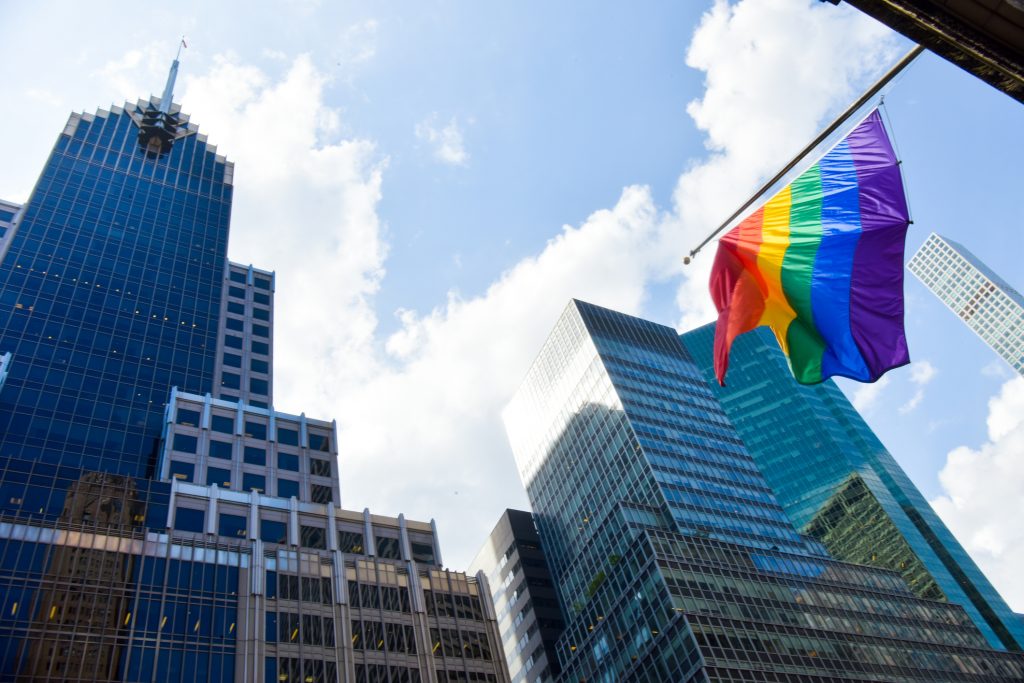“I’m just so tired, I don’t know how many times I have to remind my boss of my pronouns.”
“I was so proud of my daughter graduating. I never expected my supervisor to ask why she was wearing a suit. What’s wrong with that?”
“I was asked to put the photo of me and my husband away as not work appropriate, even though there are straight colleagues with them.”
In my work as an LGBTQ2+ educator, I have people tell me stories like these, as well as overtly traumatic moments of homophobia, biphobia and transphobia. Perhaps my social work background shines through, or when I arrive in a space representing Pride at Work Canada I am seen as a physical manifestation of the queer community. I am sometimes the first person people tell in their workplace that they are part of the community, or that someone they love is LGBTQ2+. I may just be the first welcoming face that they know won’t judge them for their sexual orientation or gender identity.
Considering the continued discrimination against LGBTQ2+ people in the broader world, having discrimination happen in our workplaces can have an even more detrimental effect. Discriminatory comments or actions can build up and have a major impact on a person’s work performance, as well as their health. The impact of such experiences can accumulate into minority stress.
What is minority stress?
Minority stress describes the impact that marginalized minority groups experience in comparison to the dominant group (Meyer, 2003; Sutherland, 2016). In the case of the LGBTQ2+ community, that means the stress that sexual minorities experience in comparison to heterosexuals, and the stress that gender minority groups like trans and non-binary people experience in comparison to cis people – those who identify with the gender they were assigned at birth. There has been considerable evidence (Meyer, 2003; Sutherland, 2016; Randall et al, 2017) that there are negative health outcomes for those who experience minority stress. When it comes to the workplace, we need to be aware of these outcomes and be able to provide support.
“Considering the continued discrimination against LGBTQ2+ people in the broader world, having discrimination happen in our workplaces can have an even more detrimental effect.”
The Canadian Mental Health Association (2019) reports that LGBTQ2+ people experience higher rates of depression, anxiety, obsessive-compulsive and phobic disorders, suicidality, self-harm and substance use than their cis heterosexual peers. They also suggest that LGB people are at double the risk for post-traumatic stress disorder (PTSD) than heterosexual people. The mental-health outcomes can be even worse for bisexual and trans communities in particular. Bisexuals have higher rates of mental illnesses than their gay, lesbian or straight peers (Pinder, 2016); the Trans Pulse Project found that 77% of trans Ontarians had considered suicide and 43% had attempted suicide at least once (Scanlon et al., 2010). These are startlingly disproportionate rates of mental illness and can be exacerbated for LGBTQ2+ people of colour, and LGBTQ2+ people with disabilities.
There is some research that suggests LGBTQ2+ people experience more negative physical health outcomes as well. These can include higher rates of asthma and arthritis among lesbian and bisexual woman, as well as certain types of cancers among varying LGBTQ2+ groups (Casey, 2019). This could be for a number of reasons, including not having access to inclusive medical professionals, increased risky behaviours as coping mechanisms and the lasting impact that minority stress has on stress hormones (Mays et al, 2018).
Minority stress in the workplace
Minority stress is reduced when there is an inclusive workplace, but a truly inclusive workplace is something that rarely is found. In Pride at Work Canada’s work, we often find that many employers want to be supportive, but are unaware of the actual lived experiences of LGBTQ2+ people and how subtle forms of heterosexism or cissexism may be integrated into everything from job postings, to employee forms, health benefits, washrooms and policies. In our report Hiring Across All Spectrums (Hixon-Vulpe, 2018), LGBTQ2+ jobseekers shared many challenges/concerns in their comments, such as:
“I will not fit in to social/organizational norms. I will be exhausted by having to come out repeatedly.”
“I am unaware if the workplace will have bathroom facilities I am comfortable using.”
“I’m concerned about the background checks that I would have to do to switch jobs. If they try to check my university degrees, I have not had an opportunity to update [my gender and name on] my records and I would have to out myself so that the proper checks can get done.”
These stories are all too common examples of small moments of minority stress that most cis heterosexual people do not even think about when coming to work.

Steps to inclusivity
We can endeavour to make workplaces that are more inclusive, where LGBTQ2+ employees experience less minority stress at work, but are also better able to cope with the minority stress of being an LGBTQ2+ person in the world. The first step is recognizing the impact that minority stress can have on LGBTQ2+ employees and their health outcomes.
We also need to make concrete changes in our workplaces. That includes changing our policies and procedures, employee forms, washroom signage and employee assistance plans. For employee assistance plans, we need to talk to our provider about how LGBTQ2+ inclusive they are, including whether they have trans-inclusive healthcare and LGBTQ2+ inclusive mental-health providers, cover HIV/AIDS medications, offer access to adoption and surrogacy supports, and more. Inclusive policies recognize that family might be different for LGBTQ2+ communities than only blood relatives and a legal spouse.
This must be paired with the creation of an overall welcoming culture that not only tolerates LGBTQ2+ people, but actively celebrates us as an important part of the workplace. With all these pieces, the minority stress on LGBTQ2+ employees will be reduced and a true sense of belonging will be cultivated.
Want the best of CareerWise delivered to your inbox each week? Subscribe to our popular CareerWise Weekly newsletter to receive top news and views in career development every Tuesday.






